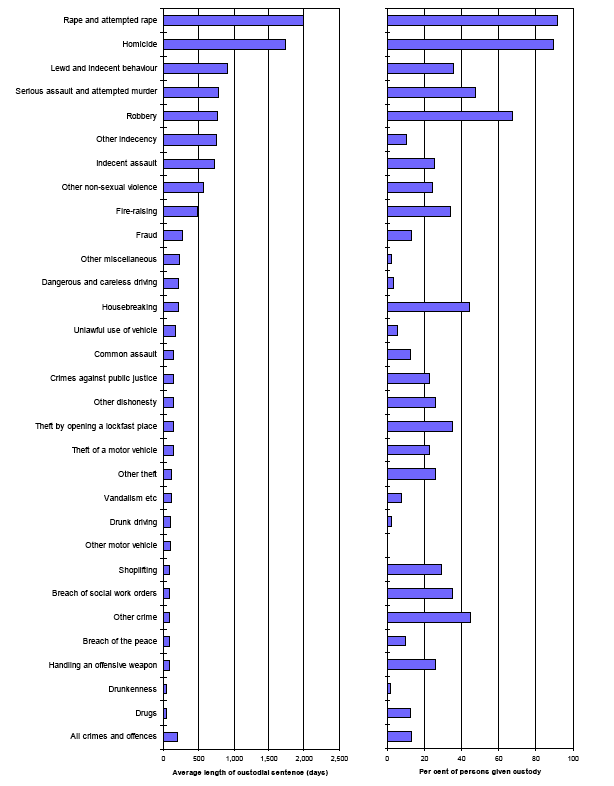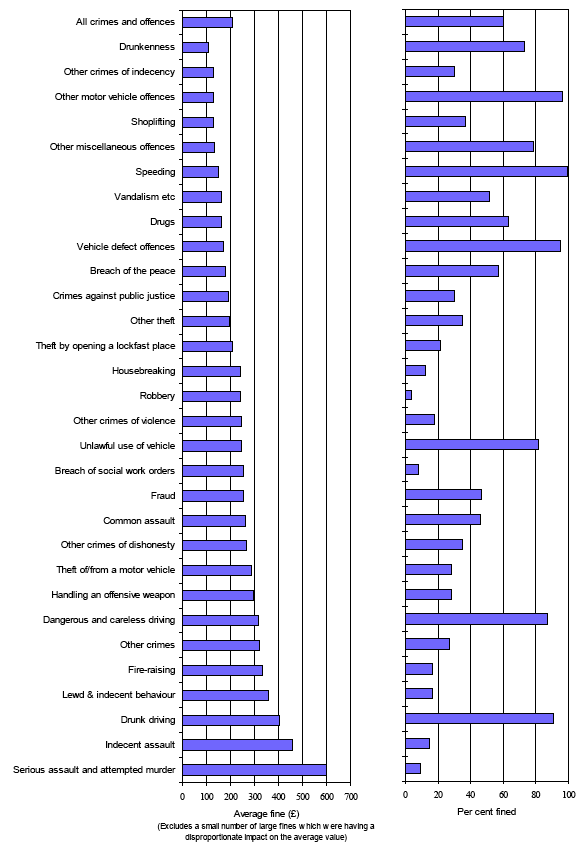Statistical Bulletin Crime and Justice Series: Criminal Proceedings in Scottish Courts, 2006/07
Criminal Proceedings in Scottish Courts 2006-07
7 Commentary: Sentencing (Tables 7 to 12, Charts 3 and 4)
Custodial sentences
7.1 The overall number of convictions resulting in a custodial sentence in 2006/07 was just under 18,200, an increase of 9 per cent on the figure for 2005/06, and the highest figures recorded during the last 10 years.
7.2 Custody is the most frequently used sentence for most types of crime involving violence. Excluding homicide, rape and attempted rape, the categories with the highest proportions of convictions resulting in a custodial sentence in 2006/07 were robbery (70 per cent), housebreaking (51 per cent) and serious assault (50 per cent).
7.3 The average length of determinate custodial sentences over most of the last decade has been between seven and eight months and was just under seven months in 2006/07. Over half (55 per cent) of all custodial sentences in 2006/07 were for three months or less; 81 per cent were for six months or less. Crimes of violence and crimes of indecency were the most likely to attract long custodial sentences. Only 1 per cent of custodial sentences for crimes of dishonesty were for over two years whereas the corresponding proportions for non-sexual crimes of violence and crimes of indecency were 39 per cent and 52 per cent respectively. In 2006/07, drug offences accounted for 19 per cent of all custodial sentences of four years or more.
Chart 3: Average sentence length 1 and per cent of custody by type of crime or offence, 2006/07

1 Excludes life sentences and indeterminate detention
Community sentences
7.4 The total number of convictions resulting in a community sentence in 2006/07 totalled just under 17,400, similar to 2005/06. Over the last ten years, the use of community sentences has generally increased as a proportion of all sentences imposed by the courts: they accounted for 13 per cent of all sentences in 2006/07 compared with 8 per cent in 1997/98. In both 2004/05 and 2005/06 community sentences outnumbered custodial sentences, however in 2006/07 there have been more custodial sentences.
7.5 In 2006/07, the number of convictions resulting in a probation order (including probation with a requirement that the offender shall perform unpaid work) was just over 9,200 (2 per cent less than in 2005/06). The proportion of convictions resulting in an offender being placed on probation was highest for indecent assault (39 per cent) followed by lewd and indecent behaviour (38 per cent) and 'other violence' (25 per cent).
7.6 The number of convictions in 2006/07 resulting in a community service order was just under 5,800, an increase of 2 per cent compared with 2005/06. In 2006/07, the categories with the highest proportion of convictions resulting in a community service order were serious assault and attempted murder (19 per cent), handling an offensive weapon (16 per cent), fire-raising (14 per cent) and fraud (13 per cent). The average length of community service order imposed in 2006/07 was 147 hours.
7.7 Other forms of community sentence were available to courts in a number of areas in 2006/07. These included restriction of liberty orders (1,300 sentences) and drug treatment and testing orders (900 sentences), supervised attendance orders of first instance (just over 100 sentences) and a small number of Community Reparation Orders and Antisocial Behaviour Orders.
Financial penalties
7.8 Between 1997/98 and 2006/07, the use of fines, the most common main penalty imposed by courts, has generally fallen as a proportion of all penalties imposed. This is in part a result of those offences most likely to be punished by fines increasingly being dealt with outside the court, for example by police conditional offers or "fiscal fines". Fines were the main penalty imposed in 60 per cent of convictions in 2006/07, one percentage point less than the proportion in 2005/06 and nine percentage points below the figure recorded for 1997/98. In 2006/07, a fine was the most frequent penalty imposed in convictions for motor vehicle offences (91 per cent), 'other' offences (79 per cent), drunkenness (73 per cent), drugs offences (63 per cent), and breach of the peace (57 per cent).
7.9 Excluding cases where a company was fined, the average fine imposed by courts in 2006/07 was £211, an increase of under 1 per cent compared with the average in 2005/06 (£212). The average compensation order imposed by courts either as main or secondary penalty was £335, a 19 per cent increase compared with the average in 2005/06 (£282).
Other sentences
7.11 In 2006/07, admonition was the main penalty in 12 per cent of convictions, one percentage point higher than in 2005/06 and two percentage points higher than in 1997/98. This type of sentence was a relatively frequent outcome in convictions for the 'other' crimes of indecency category (46 per cent of convictions), the 'other' violence category (25 per cent of convictions), crimes against public justice (24 per cent), drunkenness (22 per cent) and breach of the peace (21 per cent).
Chart 4: Average fine and per cent fined by type of crime or offence, 2006/07 (1)

1 Excludes homicide and rape
Sentencing by sex and age of offender
7.12 The pattern of penalties imposed in 2006/07 varied with the age and gender of the offender. This is likely to reflect the different patterns of offending and conviction histories of the different groups of offenders. While males accounted for 85 per cent of all convictions (excluding companies) in 2006/07, they represented 92 per cent of custodial convictions. Females accounted for 15 per cent of all convictions (excluding companies) and 26 per cent of other sentences (mainly admonition).
7.13 Between 2005/06 and 2006/07, the number of convictions resulting in a custodial sentence increased by 9 per cent. The largest percentage increase was in females under 21 (up by 70 percent). Females aged 21-30 also showed an increase (up by 11 per cent), though females over 30 showed a decrease (down by 16 per cent). For males, all age categories showed an increase, the largest being for those over 30 (up by 12 per cent).
7.14 Between 2005/06 and 2006/07, the number of convictions resulting in a community sentence increased by 1 per cent (to 14,700) for males but decreased by 5 per cent (to 2,700) for females. Decreases were recorded for all sex and age categories, except for males aged under 21 (up 8 per cent to 4,900) and females aged under 21 (up 13 per cent to just under 700).
7.15 Between 2005/06 and 2006/07, the number of convictions resulting in a financial penalty increased by 3 per cent (to 72,300) for males and by 1 per cent (to 12,500) for females. Increases were recorded for all age categories, the highest being males aged 21-30 (up 5 per cent to 25,300) and females aged under 21 (up 5 per cent to 1,600).
There is a problem
Thanks for your feedback